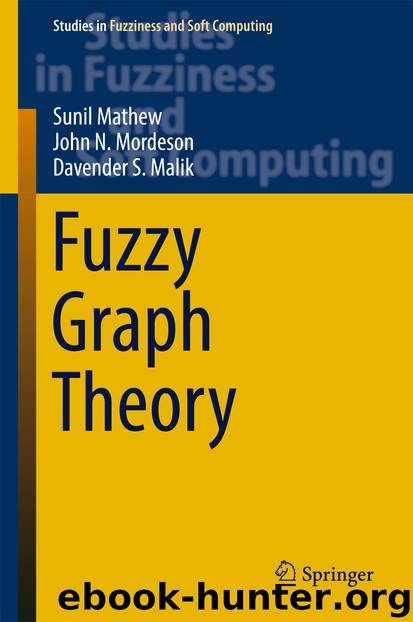Fuzzy Graph Theory by Sunil Mathew John N. Mordeson & Davender S. Malik

Author:Sunil Mathew, John N. Mordeson & Davender S. Malik
Language: eng
Format: epub
Publisher: Springer International Publishing, Cham
Suppose that (iv) is true and (v) is not true.
Fig. 4.23Theorem 4.3.1 ()
In this case, there exists three distinct vertices , and x such that x lies on every strongest strong path. Let P be a strongest strong path and u and y be the two neighbors of x in P. Let C be the cycle mentioned in (iv), containing ux and xy and Q be the path in it, which is different from . Let a be the last vertex at which Q intersects subpath of P and b, the first vertex at which Q intersects subpath of P moving from y to u, along Q. Consider the path S given by the union of subpath of P, subpath of Q and subpath of P. The strengths of subpath and subpath of P are clearly greater than or equal to because P is a strongest strong path. The strengths of the two strongest strong paths constituting C is . Because the membership values of both the edges are greater than or equal to , and so is the strength of the subpath of Q. Hence, . So, S is a strongest strong path, a contradiction as it does not contain x. It follows that our assumption is wrong. Therefore, for any three distinct vertices , and x there is a strongest strong path which does not contain x (Fig. 4.23).
Download
This site does not store any files on its server. We only index and link to content provided by other sites. Please contact the content providers to delete copyright contents if any and email us, we'll remove relevant links or contents immediately.
Modelling of Convective Heat and Mass Transfer in Rotating Flows by Igor V. Shevchuk(6359)
Weapons of Math Destruction by Cathy O'Neil(6090)
Factfulness: Ten Reasons We're Wrong About the World – and Why Things Are Better Than You Think by Hans Rosling(4635)
Descartes' Error by Antonio Damasio(3194)
A Mind For Numbers: How to Excel at Math and Science (Even If You Flunked Algebra) by Barbara Oakley(3194)
Factfulness_Ten Reasons We're Wrong About the World_and Why Things Are Better Than You Think by Hans Rosling(3169)
TCP IP by Todd Lammle(3104)
Applied Predictive Modeling by Max Kuhn & Kjell Johnson(2991)
Fooled by Randomness: The Hidden Role of Chance in Life and in the Markets by Nassim Nicholas Taleb(2981)
The Tyranny of Metrics by Jerry Z. Muller(2960)
The Book of Numbers by Peter Bentley(2883)
The Great Unknown by Marcus du Sautoy(2621)
Once Upon an Algorithm by Martin Erwig(2547)
Easy Algebra Step-by-Step by Sandra Luna McCune(2546)
Lady Luck by Kristen Ashley(2501)
Practical Guide To Principal Component Methods in R (Multivariate Analysis Book 2) by Alboukadel Kassambara(2453)
Police Exams Prep 2018-2019 by Kaplan Test Prep(2447)
All Things Reconsidered by Bill Thompson III(2333)
Linear Time-Invariant Systems, Behaviors and Modules by Ulrich Oberst & Martin Scheicher & Ingrid Scheicher(2312)
